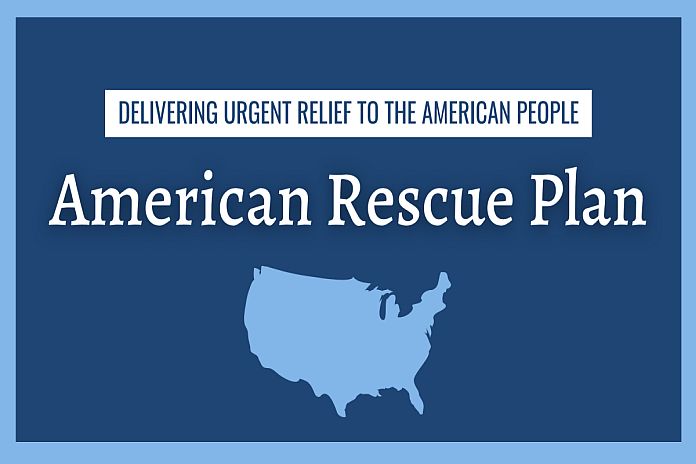By Gabriella Cruz-Martinez
Policy actions taken during the pandemic led to “the most equitable” recovery in recent history, a new government report found.
The study released first to Yahoo Finance on Monday by the Treasury Department found that the president’s American Rescue Plan Act (ARPA) along with actions taken by state and local governments prevented the worst economic outcomes for Black and Hispanic families during the COVID pandemic, groups that were the hardest hit during that time and have historically been more vulnerable to downturns.
Related: Equitable Recovery in the United States US Department of the Treasury
The federal aid – including stimulus checks, rental assistance, and the expanded child tax credit – in combination with local support and the Federal Reserve efforts helped sustain Black and Hispanic household finances, narrow the wealth gap, and improve some economic indicators relative to the pre-pandemic period.
“This report shows that, as the Biden administration policies have driven a historic economic recovery, we’ve also been building the economy we need for the long term – one that allows all communities to reach their economic potential,” deputy treasury secretary Wally Adeyemo said in a press statement. “The report shows the progress we’re making on building a more equitable economy, narrowing the racial wealth gap, and addressing enduring inequities in wealth accumulation.”
“As we continue to implement the Investing in America Agenda, we remain committed to capitalizing on the progress made during the recovery and investing in the people, places, and infrastructure that have been too often left behind,” Adeyemo added.
Federal policies helped most vulnerable
The changes enacted under ARPA helped millions of households get direct relief during the COVID crisis, especially those most economically vulnerable.
For one, the federal government sent out $500 billion in economic impact payments (EIPs), known colloquially as stimulus checks, to eligible individuals worth up to $1,400 per person. That marked the third and largest round of stimulus checks after the Trump administration oversaw the first and second distributions.
The ARPA also expanded the child tax credit (CTC), earned income tax credit (EITC), and child and dependent care tax credit (CFCTC), all of which helped reduce the child poverty rate. Additionally, small businesses received emergency grants and minority-owned businesses were eligible for aid through the small business opportunity fund.
The ARPA program also lowered or eliminated insurance premiums for millions of lower- and middle-income families and offered full continuation of COBRA health benefits. Unemployment benefits were also extended with a weekly supplemental benefit of $300 in addition to the regular $400 benefit. The first $10,200 of those benefits were not taxed for folks earning less than $150,000.
“Due to the EIPs and other federal state, and local transfers – like extended unemployment insurance – and additional factors – such as reduced spending in the height of the pandemic – balance sheets remained strong throughout the pandemic, contributing to a speedy and resilient recovery,” US Treasury researchers wrote in the report.
One measure of that resiliency is the unemployment rate. It took just 29 months for the overall unemployment rate to fall to its pre-pandemic low of 3.5 percent.
For Black and Hispanic Americans, the improvement in unemployment was just as impressive and unexpected. The unemployment rates for Black and Hispanic workers dropped to 7 percent and 4.8 percent by the end of 2021. As a result, the gaps between Black and white, Hispanic and white unemployment rates have narrowed substantially, dropping near historic lows in 2023.
Economists had predicted an overall unemployment rate of 5.5 percent at the end of 2021 and historical trends would have suggested the Black and Hispanic unemployment rates would have been 9.6 percent and 7 percent, respectively.
“Within 20 months after the COVID recession peak, both Black and Hispanic unemployment rates were lower than they were at the same time in previous recoveries and have stayed lower through the most recent data,” researchers said in the report.
Other financial measures of financial well-being for those workers on average remained either relatively strong or improved, increasing household wealth.
Delinquency rates shrunk in 2021 among Hispanic and Black households, likely due in part to stimulus checks and other federal aid. For instance, majority Black communities saw delinquency rates fall significantly in the first two years of the COVID recovery. In contrast, during the Great Recession in 2009, delinquency rates remained high among majority Black households.
The median wealth adjusted for inflation also increased between 2019 and 2022 by 60 percent and 47 percent for Black and Hispanic families, respectively, some of the largest increases in the survey’s history and larger than those experienced over the previous two recessions. By comparison, wealth grew by 31 percent for the median white family and 37 percent overall, according to the most recent Survey of Consumer Finances.
“Since Black and Hispanic families have much lower bases of wealth, the same dollar transfer to them would increase their wealth by a greater percentage,” researchers noted. “Second, on average, Black and Hispanic families both have lower incomes than white families and, thus, likely received more transfers.”
Supporting housing stability
During the pandemic, the Biden administration also enacted policies to help support housing stability.
Two programs were set in place: the emergency rental assistance (ERA) program, which provided $46 billion to support renters, and the homeowner assistance fund (HAF), which made $10 billion available to support homeowners.
Both programs were need-based, so many underserved communities were able to benefit from the assistance. According to the Eviction Lab, COVID policies such as ERA helped cut eviction filings by more than half. The largest eviction reductions were also in majority-Black neighbourhoods, which saw an eviction filing rate between Black and white neighbourhoods narrow.
According to the US Treasury report, ERA funds went to communities with higher shares of Black or Hispanic renters. On average, a renting household in an area with a population with 75 percent Black or Hispanic renters received $375 more than areas that had a renting population that was 35 percent Black or Hispanic.
“In addition, more ERA dollars went to neighbourhoods with higher shares of residents in poverty and renting households by single mothers,” researchers wrote in the study.
On the other hand, the HAF program was designed to support existing homeowners to avoid delinquencies or the risk of foreclosure during the pandemic. This measure was especially important for Black and Hispanic households, whose homeownership rates lagged far behind white households in 2020 – 44 percent and 48 percent versus 73.7 percent, respectively.
HAF assistance provided helped keep foreclosure rates low among these communities and forge a path for future homeownership among these communities after the pandemic.
Between 2019 and 2022, Black and Hispanic homeownership rose by 2.9 and 1.2 percentage points, respectively, the study found. White homeownership increased just 1.1 percentage points in that period.
“This occurred despite aggressive interest rate increases, which significantly raised the cost of borrowing beginning in early 2022,” the researchers wrote. “In contrast, homeownership rates fell over the Great Recession and rose by less for Black and Hispanic households in the 2001 recession and recovery.”







